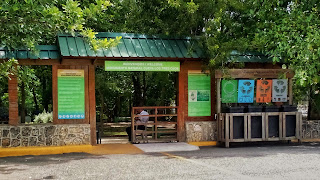Faro a Colón y Parque Nacional Los Tres Ojos

During my visit to Santo Domingo, the capital of the Dominican Republic, back in June 2023, I visited Parque Nacional Los Tres Ojos [The Three Eyes National Park] and saw Faro a Colón [Lighthouse to Columbus] along the way. The park is a great way to enjoy the outdoors not far from the city. While the lighthouse is not located in a safe space for foreign tourists, visitors can park briefly on the side of the road to get a picture.



History of Faro a Colón
Plans for a lighthouse dedicated to Columbus and built in Santo Domingo were in the works since 1931. In fact, Scottish architect Joseph Lea Gleave won a contest as a twenty-three year old for designing the best lighthouse for the spot. Despite early enthusiasm for the lighthouse, progress stalled when the consortium of countries who supported the idea did not lend financial support. A foundation was laid during the Trujillo Era, but no more progress was made. Gleave died in 1965, long before his lighthouse was constructed. The pending quincentennial, or five hundredth anniversary of Columbus landing in Hispaniola, allowed enough funds to be raised. The lighthouse was completed in time in 1992. Unfortunately, the lighthouses is rarely lit, as its 150 searchlights cause a power blackout in the nearby neighborhood. The lighthouse is claimed to be the final resting place for Columbus, although a DNA test conducted on remains buried in Seville, Spain gives some but not conclusive proof that the man is, in fact, no where near the Dominican.

Parque Nacional Los Tres Ojos
Rediscovered by American soldiers in 1916 during the American Occupation of the Dominican Republic, this trio of round, eye-like blue lakes surrounded by limestone cave walls have been the sacred spaces to the Taíno for thousands of years. Since 1968, the government has managed this site as a national park, adding long stairs for visitors to access the lakes. The park opened to the public in 1972 and has been a popular destination for locals and tourists alike ever since.






Each of the three “eyes”, plus a fourth adjoining lake, have their own names. Lago de Azufre [Sulphur Lake] is not as sulpherous as first proposed but instead receives its lovely blue color from calcium. Lago La Nevera [Refrigerator Lake] is the coldest of the lakes, as the name implies. Lago de las Damas [Lake of the Ladies] was so called because the Taíno believed the mineral water acted as a fertility treatment, and only women were allowed to bathe there. The fourth lake, Lago Los Zaramagullones, is named for a species of local waterfowl. This lake is accessible only by a ferry, which is more of a glorified milk crate pulled across by strong young men using pulleys and rope. During the Trujillo Era, this lake became stocked with edible fish like tilapia.






Some features of the cave were familiar to me, having visited many caves in the United States. Large stalactites hang from the ceiling, and stalagmites grow up from the cave floor. A single, enormous stone column stood at the top of one stairwell. What I did not expect was how the cave was so close to the surface and brightly lit by natural life. I am accustomed to caves deep underground with electric lighting.


Signage on the history of the cave, as well as wayfinding, are provided in English in Spanish. The stairs of the cave are steep and occasionally slippery, so even highly mobile visitors must take care. No ramps or alternative routes are available for those who cannot navigate the 346 stairs. The caves are currently open from 8:00 a.m. to 5:00 p.m. every day of the week regardless of season. Entry is RD$100 (US$0.45) per person with discounts for citizens and residents, and the ferry costs a few pesos more. Parking is free, and the parking lot is large. Whether driving yourself or taking a rideshare service, be sure that the GPS coordinates are for Paqueo Parque Los Tres Ojos, the parking lot, as putting in the name of the park will instead loop you around the park. As for amenities, the on-site bathrooms were recently renovated and were the cleanest among all the Dominican tourist spots that I visited. Swimming in the lakes is prohibited. If you love exploring the outdoors in a safe, regulated environment that still takes a moderate amount of athletic ability to navigate, this is a great stop.
Abby Epplett’s Rating System
Experience: 9/10
Accessibility: 4/10